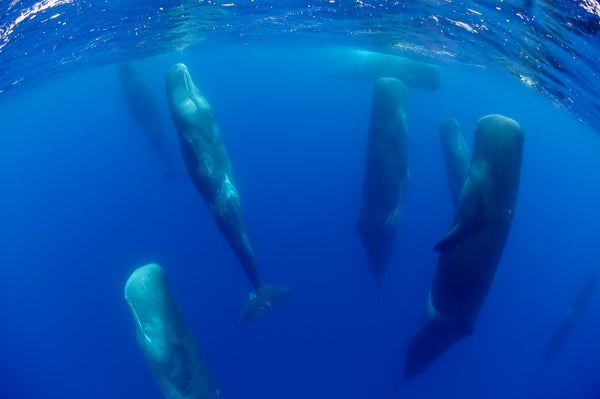Marine mammals such as whales and dolphins spend their entire lives at sea. So how can they sleep and not drown? Observations of bottlenose dolphins in aquariums and zoos, and of whales and dolphins in the wild, show two basic methods of sleeping: they either rest quietly in the water, vertically or horizontally, or sleep while swimming slowly next to another animal. Individual dolphins also enter a deeper form of sleep, mostly at night. It is called logging because in this state, a dolphin resembles a log floating at the water's surface.
When marine mammals sleep and swim at once, they are in a state similar to napping. Young whales and dolphins actually rest, eat and sleep while their mother swims, towing them along in her slipstream--a placement called echelon swimming. At these times, the mother will also sleep on the move. In fact, she cannot stop swimming for the first several weeks of a newborn's life. If she does for any length of time, the calf will begin to sink; it is not born with enough body fat or blubber to float easily.
On supporting science journalism
If you're enjoying this article, consider supporting our award-winning journalism by subscribing. By purchasing a subscription you are helping to ensure the future of impactful stories about the discoveries and ideas shaping our world today.
While sleeping, the bottlenose dolphin shuts down only half of its brain, along with the opposite eye. The other half of the brain stays awake at a low level of alertness. This attentive side is used to watch for predators, obstacles and other animals. It also signals when to rise to the surface for a fresh breath of air. After approximately two hours, the animal will reverse this process, resting the active side of the brain and awaking the rested half. This pattern is often called cat-napping.
To avoid drowning during sleep, it is crucial that marine mammals retain control of their blowhole. The blowhole is a flap of skin that is thought to open and close under the voluntary control of the animal. Although still a matter of discussion, most researchers feel that in order to breathe, a dolphin or whale must be conscious and alert to recognize that its blowhole is at the surface.
Humans, of course, can breathe while the conscious mind is asleep; our subconscious mechanisms have control of this involuntary system. But equipped with a voluntary respiratory system, whales and dolphins must keep part of the brain alert to trigger each breath.
Other methods help marine mammals to hold their breath longer than other types of mammals can. Marine mammals can take in more air with each breath, as their lungs are proportionately larger than those in humans. In addition, they exchange more air with each inhalation and exhalation. Their red blood cells also carry more oxygen. And when diving, marine mammals' blood travels only to the parts of the body that need oxygen--the heart, the brain and the swimming muscles. Digestion and any other processes have to wait.
Finally, these animals have a higher tolerance for carbon dioxide (CO2). Their brains do not trigger a breathing response until the levels of CO2 are much higher than what humans can tolerate. These mechanisms, part of the marine mammal diving response, are adaptations to living in an aquatic environment and help during the process of sleeping. Cetaceans reduce the number of breaths they take during rest periods; a dolphin might average 8 to 12 breaths a minute when fairly active only to have their breathing rate drop to 3 to 7 per minute while resting.
It is actually rare for a marine mammal to "drown," as they won't inhale underwater; but they do suffocate from a lack of air. Being born underwater can cause problems for newborn whale and dolphin calves. It is the touch of air on the skin which triggers that first, crucial breath. And necropsies sometimes show that an animal never gets to the surface to take its first breath of air. The same problem can occur when an animal is caught in a fishing net. If unable to reach the surface, or if in a panic, the animal may dive deeper, where it will be unable to breathe and suffocate.
Obviously sleeping safely at sea can pose problems, but the marine mammal system has addressed them.
